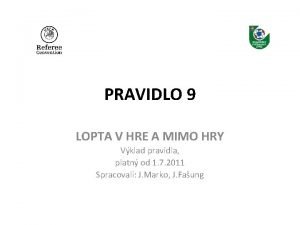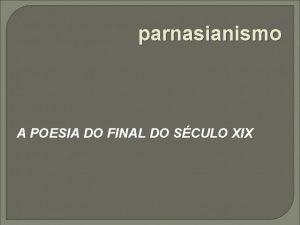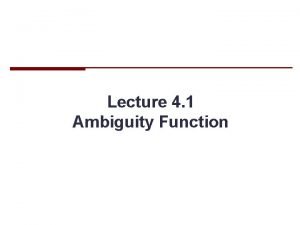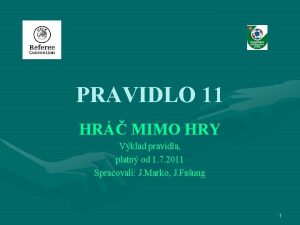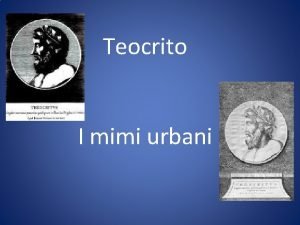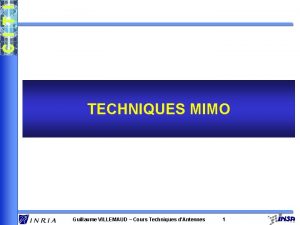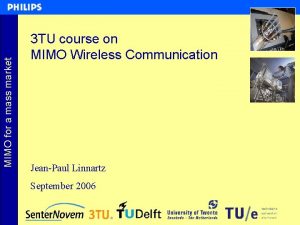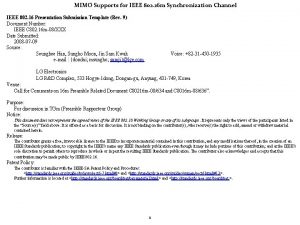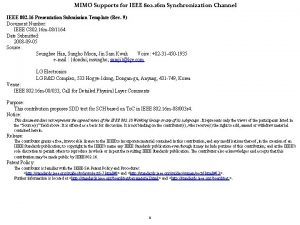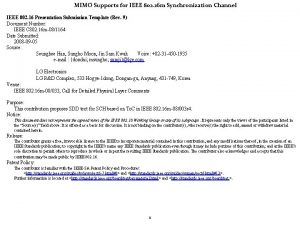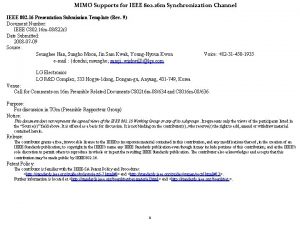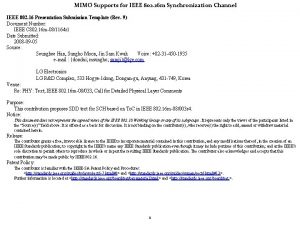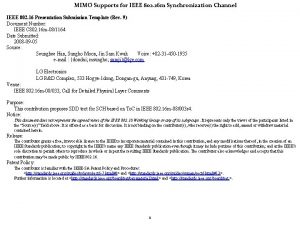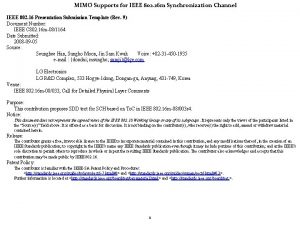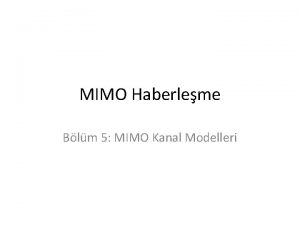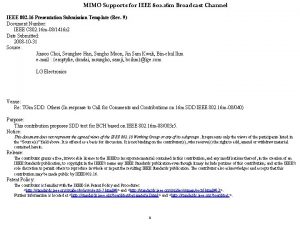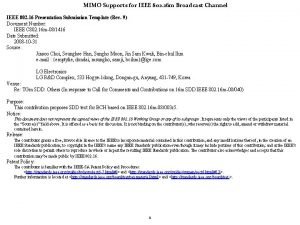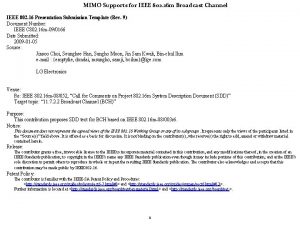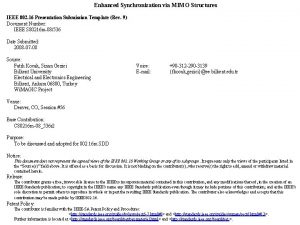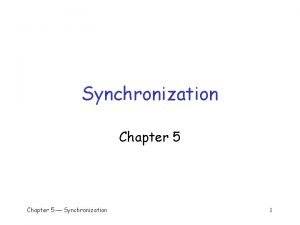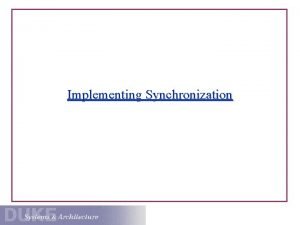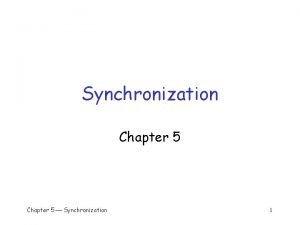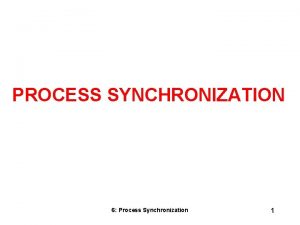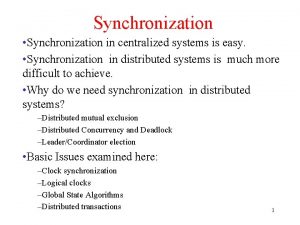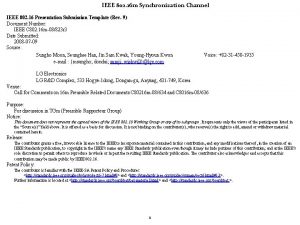MIMO Supports for IEEE 802 16 m Synchronization




















- Slides: 20

MIMO Supports for IEEE 802. 16 m Synchronization Channel IEEE 802. 16 Presentation Submission Template (Rev. 9) Document Number: IEEE C 802. 16 m-08/822 r 1 Date Submitted: 2008 -07 -09 Source: Seunghee Han, Sungho Moon, Jin Sam Kwak e-mail : {dondai; msungho; samji}@lge. com Voice: +82 -31 -450 -1935 LG Electronics LG R&D Complex, 533 Hogye-1 dong, Dongan-gu, Anyang, 431 -749, Korea Venue: Call for Comments on 16 m Preamble Related Document C 80216 m-08/634 and C 8016 m-08/636”. Purpose: For discussion in TGm (Preamble Rapporteur Group) Notice: This document does not represent the agreed views of the IEEE 802. 16 Working Group or any of its subgroups. It represents only the views of the participants listed in the “Source(s)” field above. It is offered as a basis for discussion. It is not binding on the contributor(s), who reserve(s) the right to add, amend or withdraw material contained herein. Release: The contributor grants a free, irrevocable license to the IEEE to incorporate material contained in this contribution, and any modifications thereof, in the creation of an IEEE Standards publication; to copyright in the IEEE’s name any IEEE Standards publication even though it may include portions of this contribution; and at the IEEE’s sole discretion to permit others to reproduce in whole or in part the resulting IEEE Standards publication. The contributor also acknowledges and accepts that this contribution may be made public by IEEE 802. 16. Patent Policy: The contributor is familiar with the IEEE-SA Patent Policy and Procedures: <http: //standards. ieee. org/guides/bylaws/sect 6 -7. html#6> and <http: //standards. ieee. org/guides/opman/sect 6. html#6. 3>. Further information is located at <http: //standards. ieee. org/board/pat-material. html> and <http: //standards. ieee. org/board/pat >. 1

MIMO Supports for IEEE 802. 16 m Synchronization Channel 2

Contents • • Multi-Antenna Supports in SCH Channel Estimation from SCH MIMO Support Options Comparisons between CDD and FSTD – Simulation environments – Cell ID detection error (AWGN, TU 6 120 km/h) – Beamforming effect in CDD 3

Multi-Antenna Supports in SCH • Necessity of MIMO Supports in SCH – Minimum 2 TX antennas are defined in SRD – BCH and other data will be transmitted by multiple antennas. – The SCH coverage should be larger than BCH or other channels. – There are no reasons to give up this additional diversity without additional overhead. • Coverage Comparisons – Cell ID detection performance (CDD for multiantenna transmission) • AWGN and TU 6 -120 km/h 4

Channel Estimation from SCH • Necessity of Channel Estimation for SCH – No impact on the main functionalities of SCH, e. g. , timing/freq. sync and cell ID detection (additional benefit) – SCH will be time/frequency-coherently located with BCH Better channel estimation – The BCH decoding performance is closely related to the system-operable coverage. • In order to increase the BCH decoding performance – Frequency diversity >= 5 MHz BW – Transmit diversity : spatial, time, and frequency diversity – Low code rate : strong coding or repetition Needs for additional resources • Under the condition enabling channel estimation of each antenna – SFBC is the best way for BCH compared to other schemes. • Optimal BCH decoding performance is guaranteed by – Channel estimation (Distinguishable CDD or FSTD in SCH) + SFBC (BCH) • Channel Estimation only from Pilots for BCH Decoding – Pilots are multiplexed with data and designed for the coverage of data channels. – Power boosting for pilots are needed for satisfy the BCH coverage. – Coverage losses are inevitable for data due to the power boosting. 5

MIMO Supports • Description in the Final Draft – MIMO support is achieved by transmitting SCH subcarriers from known antennas. Antennas are: • Cyclic delay diversity (with antenna specific delay values) • Interleaved either within a symbol (multiple antennas can transmit within a single symbol but on distinct subcarriers) FSTD • Across frames (only one antenna transmits in each symbol) TSTD • Or some combination – Actual approach is FFS. • Considerations – TSTD has problems in the convergence time with low mobility MSs and in power transition time from antenna on/off. – CDD and FSTD are promising candidates for 16 m SCH in multi-antenna transmissions. 6

Comparisons of MIMO Options (CDD and FSTD) • Commonalities – Multi-antenna transmission schemes for 16 m SCH – Distinguishable channel responses for each antenna – Support of various channel conditions • High mobility, Large delay spread, etc • CDD – Full frequency diversity achievable – Larger spreading gain with longer preamble sequence • FSTD – Complete separation between antennas 7

Cell Search Procedure and Simulation Environments • Major Parameters (Detailed in Annex A) – Search duration : 5 ms (coarse timing synchronization only for one SCH) – Multi-antenna transmission: CDD (1/4*Tu shifts for 2 Tx, 1/8*Tu shifts for 4 Tx), FSTD (Localized type) – System bandwidth: 5 MHz – Carrier frequency offset: random within ± 3 ppm @ 2. 5 GHz carrier frequency 8

Cell ID Detector • Full Correlator in Frequency Domain – The correlation profiles are calculated coherently for entire sequence length. – Since there always exists timing error (particularly large error after coarse timing sync step) and frequency selectivity in practical situation, it doesn’t work. • Partial Correlator in Frequency Domain – The block-wise correlation profiles are calculated in order to reduce timing error and frequency selectivity. • For intra-blocks, coherent summation • For inter-blocks, non-coherent summation • Differential Correlator in Frequency Domain – To reduce timing error and frequency selectivity. 9

Cell ID Detector (cont’d) • Observations – Full correlator is not feasible. – The performance for partial correlator depends on the size of blocks. • It needs to optimize the parameters. – Different correlator works well. • The differential correlator is deployed for evaluations. 10

Cell ID Detection Error (AWGN) • 3 ppm FO, Practical timing/freq sync, # of cells=1 – Both CDD and FSTD work well. – SFN gain for the case of two cells 11

• Cell ID Detection Error (AWGN) (cont’d) 3 ppm FO, Practical timing/freq sync, # of cells=3 – CDD is better than FSTD due to interference randomization. – For CDD, • SFN gains • Good interference randomization between cells – For FSTD, • ~0. 6 d. B SNR loss to CDD for 2 Tx @1% error rate • Severe degradation by ~2. 9 d. B SNR to CDD for 4 Tx @ 1% error rate 12

Beamforming effect in CDD • 3 ppm FO, Practical timing/freq sync, # – Not significant impact of cells=1 of frequency selectivity • No Coverage Hole – No coverage hole has been found for both CDD and FSTD. due to the beamforming in different subcarriers • Constructive subcarriers can be used to maintain the cell-ID detection performance • Impact of beamforming steerlike CDD in a certain Do. A varies in different subcarriers • The overall energies can be maintained. (Annex C) 13

• Cell ID Detection Error (TU 6, 120 km/h) 3 ppm FO, Practical timing/freq sync – 4 Tx is better than 2 Tx due to spatial diversity gain. – CDD is better than FSTD due to frequency diversity gain @ 1% error rate. • by ~0. 5 d. B for 2 Tx • by ~0. 6 d. B for 4 Tx 14

Summary • The SCH should be transmitted by multiple transmit antennas in order to satisfy the condition that the SCH has the better coverage than BCH or other channels. • In order to increase the BCH coverage with antenna diversity schemes, the SCH should be able to provide channel estimation information of the entire bandwidth during BCH decoding. • The CDD transmission of SCH has better performance in terms of the cell ID detection error than FSTD. 15

Text Proposal for IEEE 802. 16 m SDD ======= Start of text proposal for C 80216 m-08/636 ========= [The text in Section 11. x. 2. 1. 1. 5 should be replaced with the following text] • IEEE 802. 16 m preamble shall support multi-antenna transmissions with the maximum [2|4] transmit antennas. • IEEE 802. 16 m preamble shall support downlink channel estimations. The IEEE 802. 16 m preamble shall provide channel estimation information of the entire SCH bandwidth for each antenna. ========== End of text proposal =============== Start of text proposal for C 80216 m-08/634 ========= [The text in Section 11. x. 2. 1. 5 should be replaced with the following text] • The IEEE 802. 16 m SCH shall support multi-antenna transmissions with the maximum four transmit antennas. • The IEEE 802. 16 m SCH shall be used as a phase reference to broadcast channel (BCH) in the super-frame header. • The synchronization channel shall support a cyclic delay diversity (CDD) scheme with antenna-specific delay values for IEEE 802. 16 m MSs to perform full-band channel estimation for each antenna in the whole SCH bandwidth. ========== End of text proposal =============== 16

Annex A : Simulation Environments • Simulation Parameters – Carrier frequency: 2. 5 GHz – System bandwidth: 5 MHz – Sampling factor: 28/25 – Sampling frequency: 5. 6 MHz – Subcarrier spacing: 10. 9375 k. Hz – FFT size: 512 – CP length: 1/8*Tu, where Tu is effective OFDM symbol duration – Number of used subcarriers: 424 – Number of guard subcarriers: 88 – Carrier frequency offset: random within 0 ppm and ± 3 ppm – Frame configuration: All 17 DL signals, 5 ms periodicity

Annex A : Simulation Environments (cont’d) • Simulation Descriptions – Number of cell IDs: 256 – Other data channel modeling: Randomly generated QPSK signals – Sequence length for Sync channel: 212 for CDD, 212/(# of Tx antennas) for FSTD All antennas transmit the same sequences. – Sequence type for Sync channel: Randomly generated BPSK signals (not optimized about PAPR and x-correlation) – # of cells: 1, 2, 3 <cell. A(desired cell): 0 d. B, cell. B: -6 d. B, cell. C: -6 d. B> • All signals from each cell are arrived with same absolute times at MS side. – Channel model: AWGN, TU 6 (120 km/h) – Search duration for coarse timing synchronization: 5 ms (one sync channel used) – Algorithms • for coarse timing synchronization: auto-correlation based and further moving averaging to make smooth correlation profile 18

Annex B : Differential Detector • Received signal at k-th subcarrier (assuming non-repeated signals) • In AWGN, – λ: wavelength, d: antenna spacing 19

• Annex C : Beamforming Effect in CDD The overall energies can be maintained. 20
 Bridges from 802.x to 802.y
Bridges from 802.x to 802.y Bridges from 802.x to 802.y
Bridges from 802.x to 802.y Ieee 802 family
Ieee 802 family Ieee 802 3 compliance
Ieee 802 3 compliance Ieee802.22
Ieee802.22 Arquitetura ieee 802
Arquitetura ieee 802 802 ieee
802 ieee Ieee 802 standard
Ieee 802 standard 802 15
802 15 802 ieee
802 ieee Ieee 802
Ieee 802 Lopta mimo hry
Lopta mimo hry Vaso chines parnasianismo
Vaso chines parnasianismo Mimo
Mimo Postavenie mimo hry
Postavenie mimo hry (mackenzie) não caracteriza a estética parnasiana: *
(mackenzie) não caracteriza a estética parnasiana: * Mi mama me ama
Mi mama me ama Mimi urbani teocrito
Mimi urbani teocrito Mayamimo
Mayamimo Guillaume villemaud
Guillaume villemaud Mimo for dummies
Mimo for dummies











